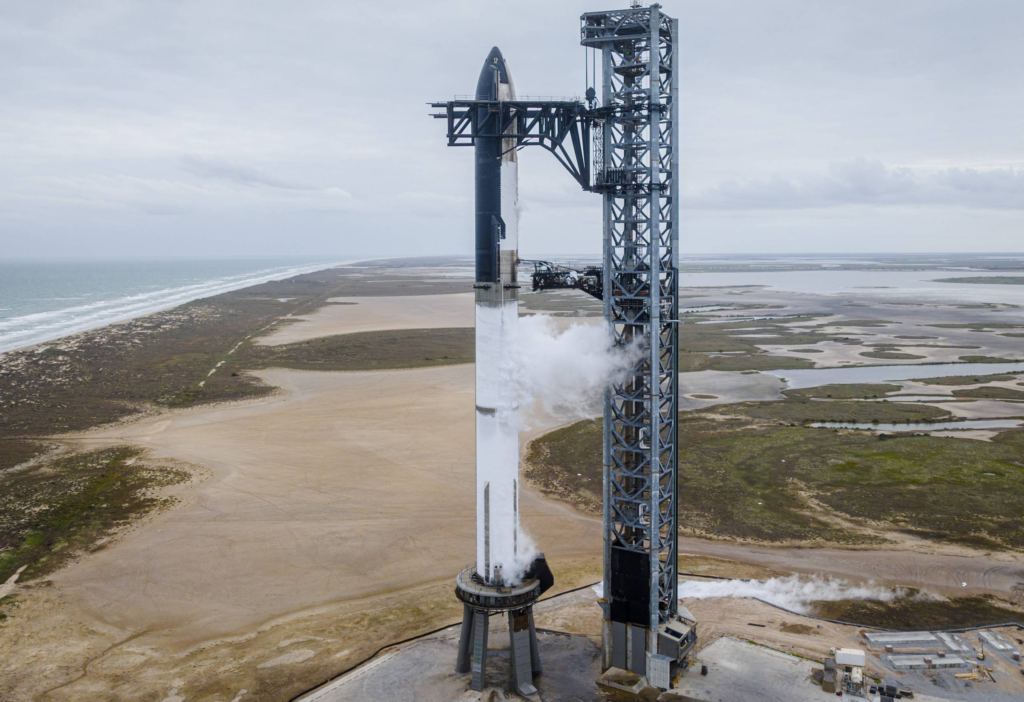
Starship Is Almost Ready For Its Orbital Test Flight
For years now we have watched SpaceX transform an empty area into a next generation launch and production site. After many initial test flights, small hops, and static fires, the company is closer than ever to the first orbital test flight of Starship. A long awaited moment that will have a significant impact on both the company and the space industry as a whole.
Currently, with the recent completion of Super Heavy’s static fire, SpaceX is working on obtaining FAA approval, along with a few other last minute preparations. Based on all these different factors, a launch as early as March is possible. Not to mention, we also received more information about Super heavy’s big test and what exactly the results are.
This gives additional insight into whether or not SpaceX will test the booster again before launch, or if the results were good enough. A very important decision considering the magnitude of this initial flight and what it could mean for the program. Here I will go more in-depth into Starship’s recent progress, the FAA approval, what to expect in the coming weeks, and more.
New Test Results

Earlier this month on the 9th, SpaceX fired nearly all of the engines in the booster of its Starship launch vehicle in a ground test. The test was meant to fire all 33 Raptors in the booster. However, Elon Musk tweeted immediately after the test that controllers turned off one engine just before the test and another stopped itself during the test. This meant that 31 of the 33 engines fired.
This brought up questions about possible extra testing because the result was not technically perfect. Either way, new information suggests that SpaceX is satisfied with the results and will not be attempting another Super Heavy Static fire. SpaceX’s static-fire test earlier this month was “the last box to check” before the vehicle’s first orbital launch attempt, likely some time in March, a company official said Feb. 21. Gary Henry, senior advisor for national security space solutions at SpaceX, said both the Super Heavy booster and its launch pad were in good shape after the Feb. 9 test, clearing the way for an orbital launch.
It’s also important to point out that the engines ran at around 50% thrust during the test. Despite the lack of two engines running and reduced thrust, Henry, suggested that SpaceX was not planning another such test before an orbital launch attempt. In a quote, he said, “Pretty much all of the prerequisites to supporting an orbital demonstration attempt here in the next month or so look good,” This is a very big deal as testing takes a significant amount of time and initial launches are often held back by varying results. If it’s true that SpaceX is fully satisfied with Super Heavy’s performance and doesn’t plan to test the booster again, there are only a few final steps necessary before a launch.
As far as Starship’s first orbital test flight, a lot could happen. Ideally, the rocket at least leaves the pad and begins accelerating out of Earth’s atmosphere. At that point, even if Starship did not reach orbit and experienced a RUD, not only would SpaceX gain a lot of invaluable information, but the pad would also be mostly intact. On the other hand, if Starship were to explode on the pad, it would be a slight setback due to the damage of such a large rocket. Either way, SpaceX will gain important information and apply it to new test articles soon after.
Assuming the launch goes well, SpaceX has very big plans soon after. Henry said the company is ready to move ahead rapidly with operational Starship launches. “We very, very quickly converge on a system that we can operationalize,” he said, starting with launches of second-generation Starlink satellites. “We have a few that are waiting very patiently to be launched on Starship.” He continued by highlighting that these initial Starlink launches will serve as a test program, refining the launch and recovery of the two stages of Starship. In addition, he hinted at Lunar Starship operations by commenting, “Somewhere in that journey that will be happening this year, we’re going to make a major pivot to the next piece of the Human Landing System architecture, by demonstrating the orbital depot needed for on-orbit refueling of the lunar lander version of Starship.”
This is a big deal for the Starship program based on its future launch contracts and missions with NASA for example. “The nice thing about tankers is that they’ve got to reenter as well,” he said. “We’ve created this rubric, in the next year or two, where we will be able to do a lot of experimentation on that thermal protection system that will allow successful reentry of Starship.”
FAA Approval

Now that we know more about Starship’s recent Super Heavy test and the company’s upcoming plans, we can take a closer look at the last important puzzle piece for this orbital test flight, FAA approval. Not only did Gary Henry give insight into future operations and some of the final tests, but also information on the FAA. He said the company still needs an FAA launch license but expects that in the “very near future” they will receive it. He also told the audience to expect some “must-see TV” sometime in March.
SpaceX has announced and planned several Starship launch dates in the past two years that have been delayed due to licensing requirements from the FAA, so a March flight is by no means 100%. The FAA considers factors such as environmental concerns and impacts on the local community near Starship’s launch site in Boca Chica, Texas. The FAA conducted a programmatic environmental assessment (PEA) that was delayed several times by regulatory complications and public interests before being completed in June 2022. At that time, the agency told SpaceX it must take more than 75 actions before launches can be approved. In the time since then, SpaceX has not released its action plan for addressing those actions. Not to mention, FAA assessments do take time and this makes it uncertain how close SpaceX would be in reaching a March launch date.
Days ago, the FAA proposed fining SpaceX $175,000 for failing to submit required positional information about satellites ahead of a Starlink launch in August 2022, according to the Washington Post. The FAA and SpaceX have not made clear in media reports whether this problem has occurred on any other of the dozens of Starlink launches SpaceX has conducted.
At the end of the day, the FAA’s main focus is public safety and making sure that if Starship’s first orbital test flight does not go as planned, nobody gets hurt in the process. With such a unique and ambitious design, it’s hard to compare Starship to anything else that has launched in the past. The question becomes how much more testing and work is required before they are satisfied and approve a launch.
SpaceX has been making significant progress toward Starship’s first orbital launch attempt. On January 23rd, Ship 24 and Super Heavy Booster 7 were filled with around 4800 tons (~10.6M lbs) of propellant and completed Starship’s first full wet dress rehearsal, simulating a launch attempt up to the moment before engine ignition. Only two and a half weeks later, SpaceX attempted to ignite all 33 of Booster 7’s Raptor 2 engines. 31 engines ignited as planned, producing 3580 tons (7.9M lbf) of thrust – the most powerful static fire test in the history of rocketry. These 31 engines would have been plenty to get the heavy lift rocket into orbit.
Looking at future operations again, with projects such as Artemis making descent strides, we are likely going to see a similar push from SpaceX on the lunar Starship. The Starship Human Landing System, is a lunar lander variant of the Starship spacecraft that will transfer astronauts from a lunar orbit to the surface of the Moon and back. It is being designed and built by SpaceX under contract to NASA as a critical element of NASA’s Artemis program to land a crew on the Moon in the 2020s.
The mission plan calls for a Super Heavy booster to launch a Starship HLS into an Earth orbit, where it will be refueled by multiple Starship tanker spacecraft before boosting itself into a lunar near-rectilinear halo orbit (NRHO). There, it will rendezvous with a crewed Orion spacecraft that will be launched from Earth by a NASA Space Launch System (SLS) launcher. A crew will transfer from Orion to HLS, which will descend to the lunar surface for a stay of several days which is to include five or more EVAs. It will then return the crew to Orion in NRHO. In the third phase of its HLS procurement process, NASA awarded SpaceX a contract in April 2021 to develop, produce, and demonstrate Starship HLS. A crewed flight will occur as part of the Artemis 3 mission, no earlier than April 2025, after an earlier uncrewed test flight successfully lands on the Moon and returns to NRHO.
On March 23rd, 2022, NASA announced its intention to procure a second crewed Starship HLS demonstration mission to the Moon, with the HLS design updated to meet new sustainability requirements. NASA intends to negotiate a sole-source award to SpaceX by exercising an option under the 2021 HLS contract. The updated Starship HLS would be used for the Artemis V mission and would compete with landers to be procured from other vendors for later landings. All of which is actually a lot closer than many think.
Conclusion
SpaceX is just about ready for the first orbital test flight of Starship. We now know that the recent static fire produced promising results to the point where the company might not need to complete another. This means one of the final steps before launch is approval from the FAA. We will have to wait and see how it progresses and the impact it has on the space industry.
